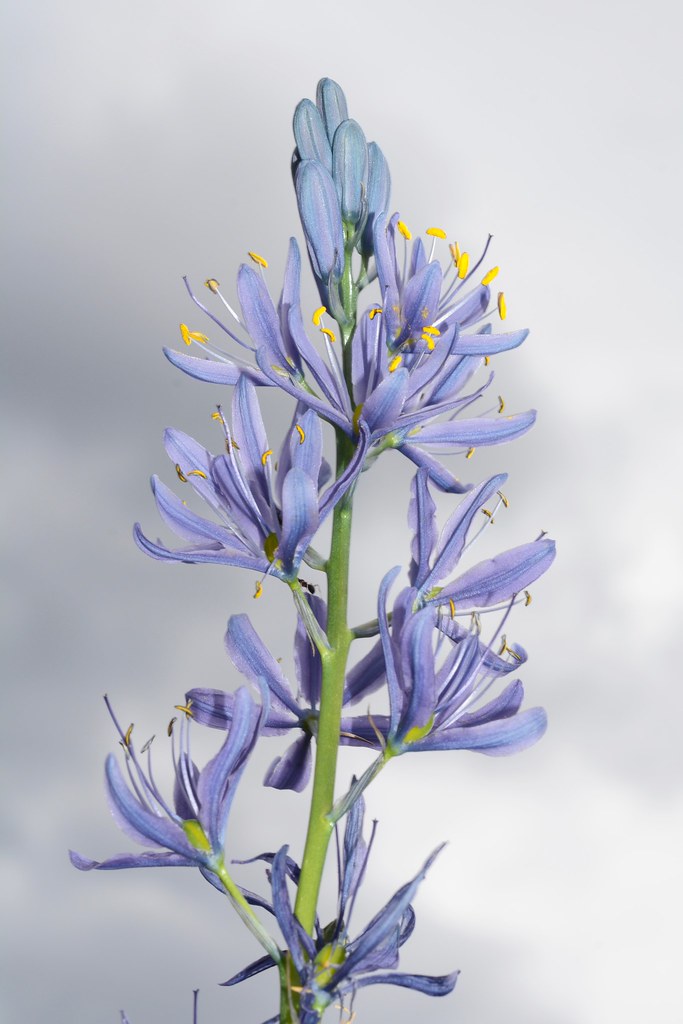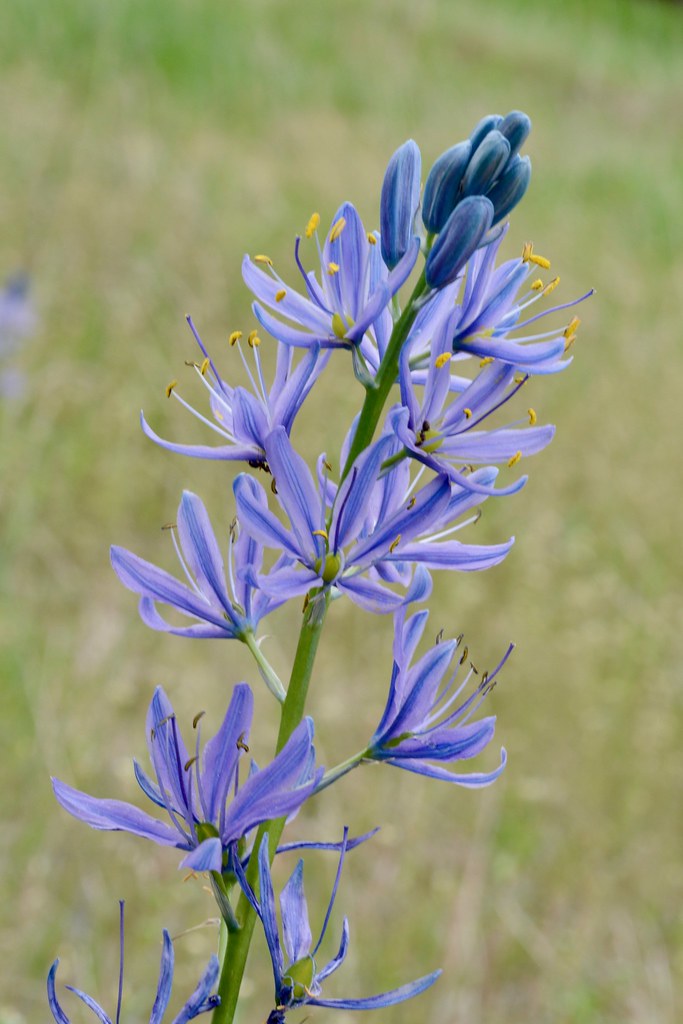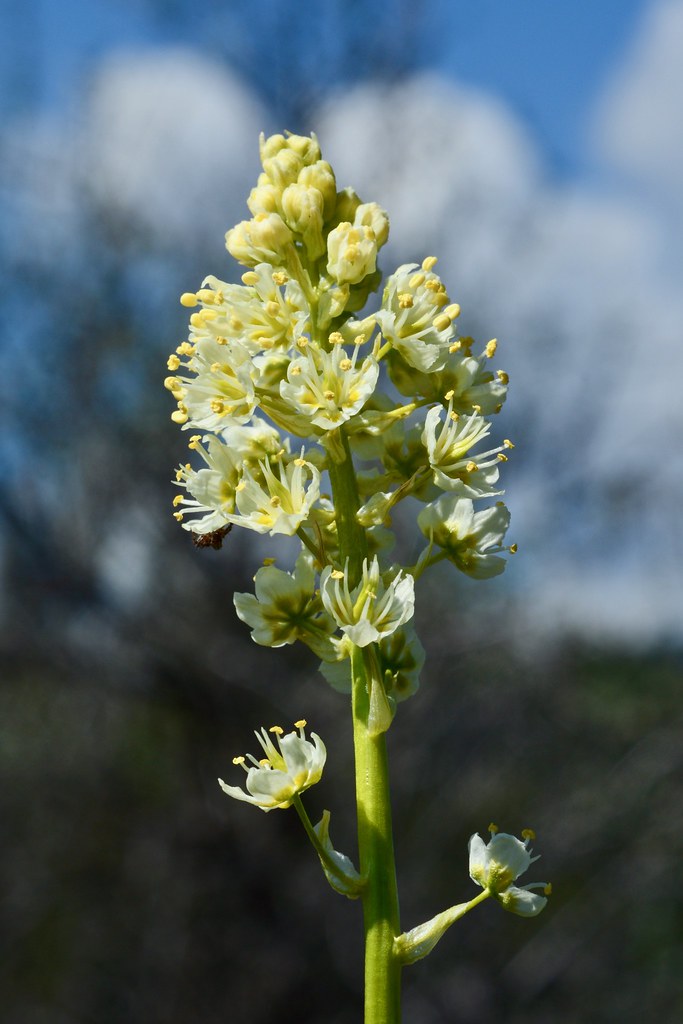May 10, 2018
Camas
There are many beautiful wildflowers in the Lily Family (Liliaceae); however not all of them are friendly. A day or so ago I encountered two different species of camas that, while they are quite different in outward appearance, they grow from bulbs that are nearly identical. There is a potential problem with that because while one has always been one of the most important “root” foods for the indigenous people of this region, the other one is poisonous and can be deadly.


Common camas, also called small camas or blue camas (Camassia quamash), was (and to some extent continues to be) a very important and prized food. Long ago it was so cherished that Indian wars were fought over select camas meadows and no other food item was more widely traded.

Meadow Death Camas (Zigadenus venenosus) bulbs and leaves contain an alkaloid, zigadenine, that is poisonous to humans and grazing animals.
RSS feed for comments on this post. TrackBack URI



Handy to know how to tell them apart.
LikeLiked by 1 person
Comment by Malcolm R. Campbell — May 10, 2018 @ 8:27 pm
I would definitely make sure the bulbs that I harvested came from the blue variety! Since they were used for trade, I wonder if there isn’t some tiny difference that marks the good from bad bulbs.
LikeLiked by 1 person
Comment by montucky — May 10, 2018 @ 8:33 pm
I feel sorry for animals accidentally ingesting the poisonous ones.
LikeLiked by 1 person
Comment by wordsfromanneli — May 10, 2018 @ 8:33 pm
A grazing animal would have to eat a lot of them before it would be fatal, although it has happened many times. Sheep are more prone to eat them and there is one instance on record where 500 sheep died from eating them. I read that a child could die from eating only 4 bulbs.
LikeLiked by 1 person
Comment by montucky — May 10, 2018 @ 8:36 pm
Wow! That’s kind of scary. I know we had an instance of someone dying from eating a hellibore that looked like wild onion or garlic. Plants can be tricky!
LikeLiked by 1 person
Comment by wordsfromanneli — May 11, 2018 @ 8:15 am
There are four species here in the lily family that are poisonous including the hellibore. The Mountain Death Camas is also poisonous and its plant structure is very similar to the wild onion. I’ve read that people who drank water in which hellibore was growing also were affected.
LikeLiked by 1 person
Comment by montucky — May 11, 2018 @ 9:55 am
I’ll bring a bottle of water from home!
LikeLiked by 1 person
Comment by wordsfromanneli — May 11, 2018 @ 10:06 am
Good idea!
LikeLiked by 1 person
Comment by montucky — May 11, 2018 @ 10:10 am
That death camas interests me for another reason. A while back, I found a plant it took me forever to identify:Nolina texana. It turned out to be a member of the lily family that goes by the common name of bear grass. It’s considered a west Texas plant, but it had popped up in the part of the hill country I visit. Lo and behold, I just checked, and your beargrass is a member of the lily family, too. The flowers of the “bear grass” I found look remarkably like the blooms of the death camas — and even a bit like your bear grass. One of these days I’ll get some photos posted so you can see what it looks like.
LikeLiked by 1 person
Comment by shoreacres — May 10, 2018 @ 9:27 pm
There is quite a tangle of names with these. I don’t understand how those who assign the scientific names let things like that happen.
LikeLike
Comment by montucky — May 10, 2018 @ 10:01 pm
I learned this flower by yet another name — green lily. Always thought that sounded “friendlier” … 😉 . The little green nectaries on the petals puzzled me. Asked several botanists their purpose but never got a clear answer. If they’re producing sweet liquid I’ve never seen bees or ants feeding on them. Hmmm … .
LikeLiked by 1 person
Comment by Sally — May 14, 2018 @ 7:33 pm
Interesting. I had never heard it called that.
LikeLiked by 1 person
Comment by montucky — May 14, 2018 @ 8:19 pm
We’re seeing lots of camas under the trees in various city parks in Salem, Or. Darker purple than your pictures. Read about the food process at one park – sounds like work. – L
LikeLiked by 1 person
Comment by Lynn Millar — May 10, 2018 @ 9:53 pm
I’ve noticed a lot of color variation on the blue camas. The amount of sun exposure might have something to do with that. I’ve read about the way they were processed too. Not just a simple process, but for a food source that important I suppose it was worthwhile and especially since they were an important trade item (almost a currency).
LikeLike
Comment by montucky — May 10, 2018 @ 10:05 pm
I love that first image with the beautiful coloured background.
It almost looks like a piece of Botanical art.
I imagine the indigenous peoples could have told the bulbs apart despite their similar appearance.
Makes you wonder if many early white settlers might have died if they ate this plant though.
LikeLiked by 1 person
Comment by Vicki — May 10, 2018 @ 10:21 pm
The background on the first photo is just the sky. I got pretty wet taking that one because the camas was growing in some shallow water.
I would guess that the settlers learned from the Indians not only that the bulbs was a good food source but also how to make sure that they had the safe ones.
LikeLike
Comment by montucky — May 11, 2018 @ 9:37 am
Beautiful photos! I’ve always liked deathcamas – probably partly because of its name. 😉 Such an odd little flower. Are these blooming right now where you are? Wildflowers down here are taking forever to get going this year!
LikeLiked by 1 person
Comment by Laura Elizabeth — May 11, 2018 @ 9:59 am
Yes, the death camas as well as the blue camas are now in full bloom. Wildflowers have been very late in blooming here too but in the past week they have started in large numbers.
LikeLike
Comment by montucky — May 11, 2018 @ 10:05 am
Beautiful studies of wildflowers but certainly it’s wise to know your way around the flowers before topping the salad.
LikeLiked by 1 person
Comment by Hanna — May 11, 2018 @ 1:22 pm
That’s for sure!
LikeLiked by 1 person
Comment by montucky — May 11, 2018 @ 2:12 pm
They both have their own beauty but I like the color of the blue one.
There are many plants out there that can kill or heal and sometimes both, and the Natives knew them all. It’s a pity we didn’t take the time to learn from them.
LikeLiked by 1 person
Comment by New Hampshire Garden Solutions — May 11, 2018 @ 3:24 pm
Yes, we could have learned a lot, and much of that knowledge is now gone.
LikeLiked by 1 person
Comment by montucky — May 11, 2018 @ 3:34 pm
Please tell me that the poisonous one tastes horrible compared to the edible one so that at least this colourblind blogger might still be saved after taking that first bite? But then again, I don’t suppose many people have tasted the poisonous one and lived to describe the taste…
LikeLiked by 1 person
Comment by de Wets Wild — May 11, 2018 @ 9:04 pm
I have no idea what either one them tastes like, but the way the native people processed them was pretty extensive. When researching them I read that 4 bulbs would be fatal to a child, but it would take more for an adult. I saw nothing written about the taste, but some of the symptoms are very unpleasant. With cattle it is said that a fatal amount would be in excess of 1% of their body weight, which would be a lot for a large animal like that, but it happens where there are large numbers of the plants in a small grazing range. The worst known incident killed 500 sheep, which are more prone to eat them than cattle.
LikeLike
Comment by montucky — May 11, 2018 @ 9:43 pm
Very Nice photos! Very interesting subject and I learn a lot from your blog. I just wish I could retain more of the information!
LikeLiked by 1 person
Comment by Reed Andariese — May 12, 2018 @ 2:32 pm
Thanks Reed. I wish that there was more good information on wildflowers: several good sources at least. Part of what keeps that from happening is that there are so many species that live only in a limited area.
LikeLike
Comment by montucky — May 12, 2018 @ 9:06 pm
Beautiful captures!!
LikeLiked by 1 person
Comment by bayphotosbydonna — May 15, 2018 @ 7:31 am
Thanks!
LikeLiked by 1 person
Comment by montucky — May 15, 2018 @ 7:43 am
Beautiful flowers .. such lovely images. It is interesting how many flowers and plants are poisonous
LikeLiked by 1 person
Comment by Julie@frogpondfarm — May 15, 2018 @ 1:41 pm
There are more poisonous plants than one would think.
LikeLiked by 1 person
Comment by montucky — May 15, 2018 @ 1:57 pm
You are so right! Daffodils and that most divine perfumed daphne … are also in the poisonous lineup
LikeLiked by 1 person
Comment by Julie@frogpondfarm — May 15, 2018 @ 8:23 pm